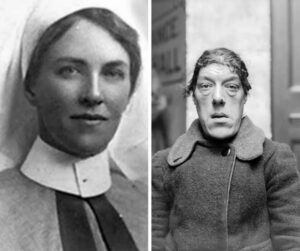Howard Fischer
Uppsala, Sweden
“May you be the proof that man can endure anything.” – Yiddish curse
“Beauty vanishes; virtue is lasting.” – Johann Wolfgang von Goethe

From the 1840s through the 1940s, “freak shows” were very popular in the western world, “a normal staple of American culture.”1 People were exhibited because of their appearances: “giants,” “dwarves,” “bearded ladies,” those with microcephaly, or other conditions that the public wanted to gape at.
Mary Ann Webster was born to a working-class English family in 1874. She would later become one of these unfortunates. She became a nurse at age twenty and married farmer Thomas Bevan in 1902. They had four children, two girls and two boys. Tom Bevan died suddenly in 1914. When Mary Ann was about thirty-two, around 1906, her facial appearance started to change, her visual fields decreased, and headaches began.2
Acromegaly in adults is a condition caused by excessive production of growth hormone, usually due to a pituitary gland tumor. In younger people, the excessive growth hormone production causes gigantism. In acromegaly, the circumference of the skull increases, the nose becomes broad, and the tongue enlarged. The mandible grows excessively and the teeth become separated. Fingers and toes become thick. Visual field defects result from compression of the optic nerves by the tumor and headaches from compression of brain structures.3
Bevan’s foot now needed a size 11 (size 44 in the European system) shoe.4 She could no longer work as a nurse and was hired to do odd jobs. Her appearance finally made her unemployable, and she had no way to support her children. Out of desperation, she answered a newspaper ad and entered an “ugliest woman” contest. She had the dubious honor of winning and was hired in 1920 for a “freak show” in the amusement park district at Coney Island in Brooklyn, New York. She spent the rest of her life with this show.
In 1927, her physician, the famed neurosurgeon Harvey Cushing, wrote to Time magazine complaining about its mocking coverage of Mary Ann Bevan: “Being a physician, I do not like to feel that Time can be frivolous over the tragedies of disease.”5 Bevan supplemented her salary by selling picture postcards of herself. During her years as a performer, she earned over $50,000 USD (about one million in today’s money).6 She managed to pay for her children’s upkeep and education, which was always her goal. She died in 1933 at age fifty-nine. Her last wish was to be buried in England.
References
- “The fascinating and tragic story of Mary Ann Bevan.” Newsner, August 23, 2022. https://en.newsner.com/wow/the-fascinating-and-tragic-story-of-mary-ann-bevan/.
- “Mary Ann Bevan.” Wikipedia.
- Pinchas Cohen and Melanie Shim. “Hyperpituitarism, tall stature, and overgrowth syndromes.” In Robert Kliegman et al (eds), Nelson Textbook of Pediatrics 18th ed, Philadelphia: Saunders, 2007.
- “Mary Ann Bevan: The tragic story of the ‘ugliest woman in the world.’” Rare Historical Photos, December 4, 2022. https://rarehistoricalphotos.com/mary-ann-bevan-ugliest-woman/.
- Harvey Cushing. TIME Magazine May 23, 1927. https://content.time.com/time/subscriber/article/0,33009,730544-3,00.html.
- Rare Historic Photos, “Tragic story.”
HOWARD FISCHER, M.D., was a professor of pediatrics at Wayne State University School of Medicine, Detroit, Michigan.
Highlighted Vignette Volume 16, Issue 1 – Winter 2024

Leave a Reply